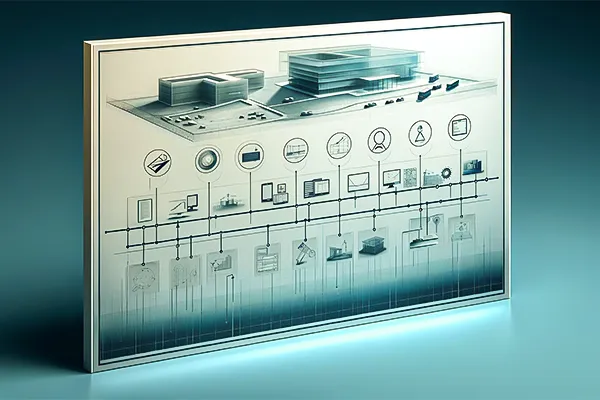
BIM Coordination Explained
Do you also wonder how construction projects that have complex designs turn out to be nothing but perfect? Do the complexities of design and engineering stun you too? Do you wonder how stakeholders resolve conflicts in designs or among teams? Well, we have answers to all the questions that you might have and then some.
In today’s blog, we aim to focus on Building Information Modelling (BIM) Coordination and how it facilitates project teams. Read the blog till the end to learn more about the concept of BIM and how it benefits the stakeholders.
What Is Meant by BIM Coordination?
As you are aware, BIM has transformed the world of construction and architecture. However, we must mention that BIM is more than a tool that offers collaboration and improves efficiency. The stakeholders can mitigate risks and resolve clashes even before they arise due to solid collaboration and coordination.
Let’s dive right into how BIM continues to revolutionize the industries that utilize the tool for their projects.
Building Information Modelling (BIM) Coordination; The Concept
A construction project’s stakeholders (architects, engineers, facility managers, etc.) utilize BIM technology to make the most of BIM Coordination. Allow us to mention that BIM Coordination is a process of integrating design and construction elements while using BIM as a central platform. Since all the stakeholders get to work through one centralized model, there is zero to no chance of clashes and errors in the workflow. And even if there are any clashes, they can be detected well before the time to ensure smooth project delivery.
The early clash detection ensures that all teams collaborate and coordinate productively to get things done. By doing so, BIM technology boosts the confidence of the concerned teams who work towards a successful project or two. In conventional building methods, the stakeholders did not have much control over the project nor were they able to detect clashes as efficiently as they can now. Thanks to technological advancements; the architecture, engineering and construction (AEC) industries are becoming more efficient by the day.
Let’s have a look at the step-by-step process of the BIM Coordination in this part of the blog!
Process of BIM Coordination

The process of BIM Coordination is a detailed one as it requires all the disciplines to come together to work towards the completion of the project. Allow us to mention that completion is not the only goal of the teams. They are supposed to thoroughly read the designs, assess them and improve them as per the project requirements. We would like to talk about the various aspects of the BIM Coordination Process in this part of the blog.
1. Design Coordination
The first step of any construction project is to work on the design. Several teams sit together to work on the design and later on, read it to know if any clashes need to be removed. These teams include architects, engineers, consultants, BIM Managers as well as regulatory authorities. Since all teams are experts in their domains, their ultimate goal is to streamline the workflow and efficiently assign resources to get started. But this step is not as easy as it seems to be. Let’s get to know why!
During the design process, the multidisciplinary teams are required to contribute towards their respective domains. For example; architects would develop architectural designs including floor maps, elevations, etc. And will also coordinate with other design teams to make sure that their designs are fulfilling the requirements. Mechanical engineers, on the other hand, would contribute towards the Heating, Ventilation and Air Conditioning (HVAC) systems.
Similarly, Speciality Consultants would get to the project to provide consultation on sustainability, accessibility, etc. This teamwork ensures that all teams are on the same page while also efficiently contributing towards successful project delivery.
2. Improved Collaboration
Without being able to collaborate with your project teams, you cannot move in the forward direction. Correct? And that’s how BIM Coordination facilitates each & every team member. When BIM technology is incorporated into a project, the team members can ensure that they are on the right track and are also super aligned to achieve their goals. So, when the design is complete, the designers reach out to other teams to discuss the technicalities, etc.
During the review meetings, clash detection is also performed so that the changes can be communicated and implemented. Once the design is revised, it is analyzed again to see if it’s following the project requirements. BIM Coordination enables the stakeholders to effectively coordinate and collaborate to get the required things done in such a way that it doesn’t impact the overall project efficiency. However, there is more to it! Continue reading the blog to learn how BIM Coordination allows seamless collaboration among project teams!
With BIM, the stakeholders don’t have to meet in person to discuss anything. They can arrange virtual meetings to analyze and review the 3D models. In addition to that, they can also detect clashes and offer solutions to mitigate the risks before the construction is initiated. Since BIM offers real-time collaboration, it becomes easier to visualize every aspect of the design. Even the tiniest of details can be viewed and then the project teams can proactively explore possible solutions.
3. Enhanced Visualization
Speaking of visualizing the 3D models and their intricate details, we must talk about how the process of BIM Coordination offers enhanced BIM visualization. When the 3D models have been created, several elements can be viewed in detail. These elements are not only crucial for the overall development but they can also make or break the project. Allow us to share what types of elements can be analyzed through highly detailed 3D models.
The stakeholders can assess the geometry and spatial relationships among the various design elements of a built environment. In addition to that, they can also analyze materials and assign relevant structural characteristics within the BIM model. Furthermore, the project teams can also evaluate and discuss lighting and the building being energy efficient. We would also like to mention that the enhanced visualization also allows for virtual walkthroughs to fully imagine and understand how the project will turn out to be.
Informed decision-making is crucial for all types of construction projects – regardless of their scale and BIM Coordination makes that possible throughout the lifecycle of the project.
4. Parametric Modelling
When a 3D model is created, it is analyzed to see if it is meeting the project requirements. If the changes are to be incorporated into the model, then they must be done in real-time so that all the stakeholders can see the progress. Otherwise, it won’t just create misunderstandings among the team members but will also impact productivity. And that’s something no one would want to happen. So, to ensure that everything is on point and is also meeting the set deadlines, BIM technology provides the stakeholders with parametric modelling. We would like to discuss how that positively impacts a construction project.
Parametric modelling is a detailed process which involves object-based modelling as the first step. What happens in object-based modelling is that BIM assigns objects their properties in such a way that they stay interconnected. And whenever a change takes place, the objects can dynamically respond to changes. This 3D environment is highly intricate and insightful so that anyone who sees it can tell about the dimensions, materials and even performance of the objects that are going to be utilized.
Parametrization in BIM allows flexibility and makes the overall construction project super efficient. Since relationships between objects and their characteristics are established, any change in the parameter will automatically reflect in the 3D model. These changes are adjusted in the surroundings in such a way that consistency and accuracy are maintained in the model. This also allows optimized designs and enables everyone to keep moving in the forward direction; that is successful project completion.
5. Improved Documentation
Without having access to project-related documentation, you cannot keep track of all that’s happening. BIM Coordination allows improved documentation where all the stakeholders can update and maintain records of each step. The best thing about incorporating BIM into any project is that it allows the uploading and updating of documentation in real time. This key feature enables informed decision-making that is crucial for finalizing the processes, resource allotment, etc. In addition, improved documentation also allows last-minute calls even more effective. All that is essential for maintaining consistency throughout the lifecycle of the project.
We are sure that you guys understand how crucial the successful delivery of any project is for the reputation of your company. BIM Coordination ensures that each stakeholder goes back satisfied when they have completed the projects.
In this part of the blog, we would like to mention a couple of benefits of BIM Coordination.
Benefits of BIM Coordination

1. Time & Cost Savings
Building Information Modelling (BIM) is a cost-efficient tool that makes it easier for the project teams to meet their project requirements without putting a dent in their pocket. In addition, so much time can be saved through BIM which can be spent on other important tasks.
Suggested: 7 Best Practices for Accurate BIM-based Cost Estimation
2. Clash Prevention
With BIM, early clash detection becomes possible without the stakeholders having to waste their time or money on flawed designs. With the automated clash detection tools, the project teams can help mitigate risks even before the construction process is initiated.
3. Improved Lifecycle Management
BIM also offers enhanced lifecycle management – that too throughout the lifecycle of the project. The concerned teams enjoy as-built documentation and accurate information to make decisions for the current operations as well as for informed future planning.
If you are looking to integrate BIM into your construction projects, then feel free to reach out to our team at DDC Solutions. Our experts are ready to help you meet your personal and professional goals in record time.

2 Responses